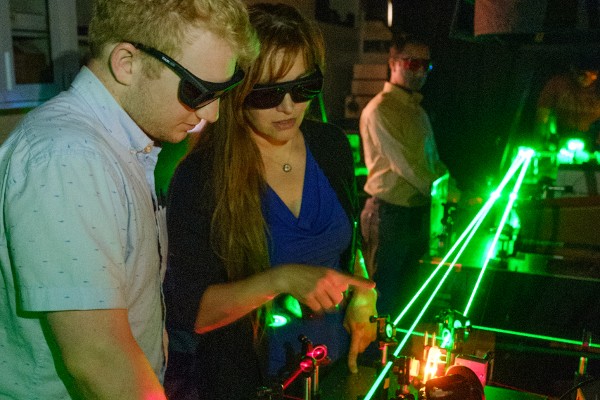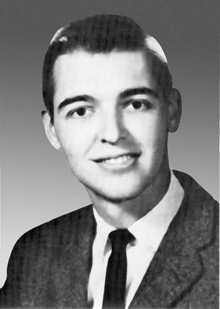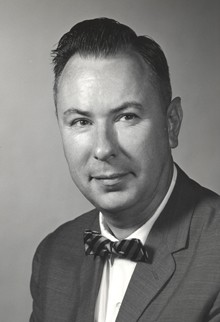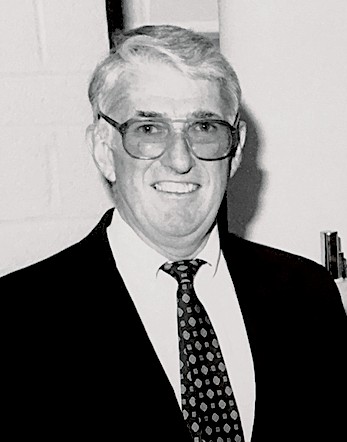Location and Time
Seminars are held on Wednesdays in 221 Kreger Hall at 4:25 p.m., unless otherwise noted.

Physics seminars serve as a dynamic platform where researchers and scholars come together to exchange knowledge, discuss cutting-edge discoveries, and delve into the intricacies of the physical world.
Seminars are held on Wednesdays in 221 Kreger Hall at 4:25 p.m., unless otherwise noted.
Email Leanne Basham for weekly seminar notifications.

The George C. Benson Memorial Lectures are in honor of a man whose memory lives with those whose lives crossed his. George spent the years 1960 to 1962 at Miami earning his Master's Degree in Physics. A native Ohioan, he attended public schools in Lodi, Ohio prior to entering Wittenberg College, class of 1958. For two years he taught high school physics, chemistry, and general science at Olmsted Falls, Ohio. His next two years in Oxford gained him the friendship and respect of faculty, fellow students, and others who knew him. His outstanding performance continued at the University of Michigan, where in December 1966 he earned his Ph.D. in Physics, his dissertation topic being "Mesons and Spectator Protons at 3.65 BeV/c." Three months later he died in an airplane crash which killed all aboard.
For years these lectures have brought distinguished speakers, including four Nobel Laureates, to the Miami University campus. The talks have been interdisciplinary in nature, showing the relationship of physics to other fields of human endeavor. They have ranged in subject from Henry Margenau's discussion of the interaction of physics and philosophy to discussions of the relevance of physics to music, medicine, and our environment. The public, as well as the university community, is encouraged to attend all talks.
If you would like to help continue this valuable lecture series, please send a contribution addressed to "Miami University Fund - George C. Benson Memorial Lectures."
2023, Distinguished University Professor, University of Maryland
"Scaling Down the Laws of Thermodynamics"
2019, Alumna, Atmospheric Scientist, Center for Severe Weather Research
"Into the Storm...Oh, the Places Mobile Rader Can Go!"
2018, Alumnus, Editor-In-Chief, Astronomy
"The New Cosmos: Astronomy's Ongoing Revolution"
2017, President and Professor of Physics, Miami University
"Physicians and Physicists: The Power of Collaboration"
2016, Case Western Reserve University, Warner and Swasey Observatory
"Gravity and Cosmology a Century after Einstein"
2015, Alumnus, Space Biology Project Manager, NASA Ames Research Lab
"Space Biophysics: Accomplishments, Trends, Challenges"
2014, Professor emeritus, University of Illinois
"The Physics of Baseball: You can Observe a Lot by Watching"
2013, National Institute of Standards and Technology, University of Colorado
"How symmetric is the electron? Looking for out-of-roundness of 10-15 femtometers"
2012, University of Maryland
"Laboratory Models of the Earth's Core"
2011, Martek Biosciences Corporation
"What does physics have to do with nutrition, omega-3 fatty acids, and brain development?"
2010, Wyle Laboratories, Inc
"Non-Destructive Testing: Applied Principles of Physics"
2009, Pennsylvania State University and Positronics Research, LLC
"Antimatter: History, Science and Opportunities"
2008, University of California, Irvine
"In Case of Abrupt Climate Shift, Break Glass"
2007, University of Minnesota
"Magnetism at the Nanoscale: A Voyeurs Tale"
2006, Florida Institute of Technology
"The Science of Space Weather"
2005, Case Western Reserve University
"Einstein's Biggest Blunder?: A Cosmic Mystery Story"
2004, Rice University
"Nanoshells: Using Nanotechnology to harvest light for Biomedicine"
2003, Harvard University
"Micro-electromagnets for the Manipulation of Magnetic Particles"
2002, DuPont Photomask
"Physics and Technology of Integrated Circuit Lithography"
2001, National Institute of Standards and Technology
"Almost Absolute Zero: The Story of Laser Cooling and Trapping"
2000, Carnegie Institution of Washington
"Extrasolar Planets"
1999, University of Arizona
"The Art and Science of the Motorcycle"
1998, NASA Goddard Space Flight Center
"High Energy Solar Physics"
1997, Sr. VP of R&D and Director of Laboratories, Hewlett Packard
"Towards Pervasive Information Systems"
1996, United States Air Force Academy
"Using the World Wide Web for Teaching & Learning"
1995, State University of New York at Albany
"Experimental Meteorology"
1994, AT&T Bell Laboratories
"Semiconductor Optical Microresonators"
1993, University of Michigan
"Fraud, Plagiarism, and the Integrity of Science"
1992, University of Chicago
"Microscopes for Quarks: Telescopes for Galaxies"
1991, West Virginia University
"Women in Science: What is the Problem and What can be Done?"
1990, Stanford Linear Accelerator Center
"Big Accelerators — Small Distances"
1989, University of California at San Diego
"High Temperature Superconductors"
1988, Fermilab
"The Early History of the Universe"
1987, Louisiana State University
"On Stars, Galaxies, and Their Distances"
1986, AT&T Bell Laboratories
"Artificial Intelligence: Panacea of Fraud?"
1985, University of California at Berkeley
"Is Anybody Out There? The Search of Extraterrestrial Intelligence"
1984, Pennsylvania State University
"The Rainbow Bridge"
1983, Los Alamos National Laboratory
"Nuclear Test Ban and Nuclear Arms Reduction"
1982, Purdue University
"A Renaissance of Modern Man: The New Cosmology"
1981, General Motors Research Laboratories
"Physics Research in Industry"
1980, University of Arizona
"General Relativity, Cosmology, and Laser Technology"
1979, New York University
"Evoked Neuromagnetic Fields of the Human Brain"
1978, University of Illinois
"Application of the Laws of Mechanics to Physical Education and Sports Medicine"
1977, Lake Forest College
"Laser Holography: A Demonstrated Lecture"
1976, University of Dublin
"Nuclear Physics — From Phosphorescence to Particle Accelerators"
1975, Hale Observatories
"Did the World Begin?"
1974, University of Wisconsin
"Medical Physics: Converting an Art to a Science"
1973, Director, Oak Ridge National Laboratory
"Social Institutions and Nuclear Energy"
1972, Case Western Reserve University
"New Woodwind Screeches and Baroque Oboes"
1971, Astronaut, NASA Manned Spacecraft Center
"Is the Moon a Heavy Electron?"
1970, Woods Hole Oceanographic Institution
"Earth Science Comes of Age"
1969, Yale University
"The Western World and the Sacred Cow"

George B. Arfken was a professor of physics from 1952 to 1983, and chair of the department from 1956 to 1972. Widely known for his college text, Mathematical Methods for Physicists, George was loved by his colleagues and generations of students. He endowed this fund in his name and that of his late wife, Carolyn, as a tribute to the closeness the couple felt to members of the physics department and their families, and to recognize her efforts on behalf of the department.
This program provides extended visits by distinguished physicists, providing significant opportunities for faculty and students to interact with the scholar. During the campus stay, the Scholar-in-Residence participates in one or more seminars with faculty and students, delivers a presentation to the university community, and works with undergraduate and graduate students on research and related topics.
If you would like to support this program, please send a contribution addressed to "Miami University Fund - George and Carolyn Arfken Physics Scholars-in-Residence Program."
2023, University of New Mexico
Public Lecture: "Breaking Heisenberg – Controlling the Quantum World"
Physics Seminar: "Quantum Computing with Neutral Atoms"
Short Courses: "Open Quantum Systems and Quantum Measurement," & "Continuous Measurement and Quantum Trajectories"
2018, University of Seville, Spain
Public Lecture: "Brownian ratchets: from statistical physics to bio and nano-motors"
Physics Seminar: "Brownian Ratchets: From Brownian Motors with Hidden Symmetries to Sub-Fourier Sensors"
Short Courses: "Introduction to Stochastic Processes," & "Vibrational Mechanics in an Optical Lattice"
2017, University of New Mexico
Public Lecture: "What the #$*! do We (k)now!? About Quantum Mechanics"
Physics Seminar: "Gravitational-Wave Detections: What Did LIGO Detect, and When and How Did It Do It?"
Short Courses: "Quantum Metrology: An Information-Theoretic Perspective"
2015, Louisiana State University
Public Lecture: "Magnetic Refrigeration...the New Cool"
Physics Seminar: "Giant Multicaloric Effects in a NiMnSi-based Alloy"
Short Courses: "Studying Magnetic Materials with Light-Sensitive Techniques, parts 1 & 2"
2015, Temple University
Public Lecture: "Quantum Optics and Precision Measurements with Diatomic Molecules"
Physics Seminar: "Study and Control of Molecular States Using the Autler-Townes Effect"
Short Courses: "Analysis of Emission and Absorption Spectra of Diatomic Molecules," & "Modeling of Quantum Optics Experiments Using Density Matrix Formalism"
2013, Delaware State University
Public Lecture: "Exploring Martian Rocks and Soils With Single Laser Pulses: A Wonderful Journey of Remote Analysis of a Planetary Surface"
Physics Seminar: "Correcting for variable laser-target distances of ChemCam LIBS measurements using emission lines of Martian dust spectra "
Short Courses: "Photo-thermal laser spectroscopy and applications," & "Early detection of ovarian cancer using laser induced breakdown spectroscopy"
2011, University of Oregon
Public Lecture: "Chaos, Quantum Mechanics, and Cooling Atoms with Laser Light"
Physics Seminar: "Controlling the Motion of Ultracold Atoms"
Short Courses: "Optical Lattices and the Casimir-Polder Effect," & "Dynamics Under Continuous Position Measurements"
2011, University of Nebraska - Lincoln
Public Lecture: "Magic of Magnetism: From Compass Needle to Data Storage"
Physics Seminar: "Ferroelectric Tunnel Junctions: Controlling Electron and Spin Transport by Ferroelectric Polarization"
Short Courses: "Physics of Spin Dependent Tunneling," & "Electronically-Driven Magnetoelectric Phenomena at Interfaces"
2009, University of Arkansas
Public Lecture: "Fate and the Physicists"
Physics Seminar: "Energy Restraints for Quantum Computation"
Short Courses: "Entanglement in Cavity QED," "The Giant Kerr Effect," & "Quantum Information Processing"
2009, Rutgers University
Public Lecture: "Physics on Rollerblades"
Physics Seminar: "Can Students Develop Scientific Habits of Mind in an Introductory Physics Course"
2008, Stanford Linear Accelerator Center
Public Lecture: "Colossal Microscopes: The Technology of Accelerators"
Physics Seminar: "Electron Beam Diagnostics for SLAC Linac Coherent LIght Source"
2007, Harvard Medical School
Public Lecture: "Light and Molecules: Directions in Biomedical Imaging"
Physics Seminar: "The Quest to Beat the Resolution Limit of Light"
Short Courses: "Biomedical Microscopy" & "Photodynamic Therapy and Photodiagnosis"
2005, Old Dominion University
Public Lecture: "Order, Disorder and Discovery"
Physics Seminar: "Mesoscopic Electromagnetic Dynamics in Atomic Gases"
Short Courses: "Precision Measurements with Quantum Beat Spectroscopy" & "Electromagnetically Induced Transparency in Atomic Physics"
2004, University of Maryland
Public Lecture: "Asteroids: Shedding New Light on Old Rocks"
Physics Seminar: "Gravitational Reaccumulation in the Solar System"
Short Course: "Numerical Methods in Planetesimal Dynamics"
2004, Massachusetts Institute of Technology
Public Lecture: "The Role of Lithography in Nanoscale Science and Engineering"
Physics Seminar: "Lithography: the Key Enabler of Current and Future Research and Industries"
Short Course: "The Art & Science of Electron-Beam Lithography
2002, Brigham Young University
Public Lecture: "The Discovery of Radioactivity and Randomness in Nature"
Physics Seminar: "Size-Dependent Melting of Indium Nanostructures"
Short Course: "PAC with Time-Dependent Perturbations"
2002, SUNY Stony Brook
Public Lecture: "Waves and Particles in Quantum Optics"
Physics Seminar: "Spectroscopy of Laser Cooled Francium"
Short Course: "Cavity Quantum Electrodynamics"
2000, IBM-Almaden Research Center
Public Lecture: "Bits of the Future: What's in Store for Hard Drives?"
Physics Seminar: "Physical Limits of Magnetic Storage"
Short Course: "Magnetic Properties of Materials"

Joseph Priest was a long-time faculty member of the Department of Physics at Miami University. He earned his master’s degree in physics from Miami University and his physics Ph.D. degree from Purdue University. After a couple of years working for IBM in New York, Joe joined Miami in 1962. During his 45 years as a member of the physics faculty he built a reputation as a brilliant physicist and a beloved educator. He was an educational pioneer and one of the first to introduce personal computers into the physics teaching laboratory, and he was the mastermind and curator of the legendary Culler Hall Foucault Pendulum. He received many honors while at Miami, among others, he was one of the first recipients of the College of Arts & Science Distinguished Educator Award, he was Sigma Xi Researcher of the Year, he was named Miami University Distinguished Professor, and was awarded the Benjamin Harrison Medallion, Miami’s most prestigious award.
Alumnus Brant Watson (BA ’64, MA ’65) was Joe’s first graduate student at Miami; Brant endowed this lecture series to honor his advisor who set the foundation of Brant’s later success. After earning his physics degrees from Miami, he went on to earn his Ph.D. in physics from Florida State University. Following a postdoc at FSU, he became involved in medical research at the University of Miami and eventually became Professor of Neurology and Biomedical Engineering at the University of Miami Miller School of Medicine.
Brant is convinced that complicated medical problems can be mitigated with direct physical methods, and his success at the University of Miami proves him right.
April 10th, The Shriver Center, Heritage Room
6:30 p.m. Pre-reception
7:00-8:00 p.m. Lecture, followed by Post-reception until 9
Professor Mark Saffman
Johannes Rydberg Professor, Wisconsin Quantum Institute Director
Department of Physics
University of Wisconsin - Madison
"ABCs of Rydberg physics: from Atoms to Bottles to Computers"
One hundred years ago Quantum Mechanics was invented and applied first to understanding the structure of atoms. A hundred years later, the tables have turned, and atoms are now a resource for gaining a deeper understanding of quantum mysteries, and for building a new generation of quantum powered computers. In the last few years remarkable progress has been achieved with neutral atom arrays, and they are now established as a leading platform for quantum information processing. In this talk I will delve into aspects of Rydberg atom physics that endow these highly excited atoms with remarkable properties and show how we can trap, control, and program their quantum states to enable new capabilities for solving some of the world’s most pressing challenges.
Join the event virtually on April 10th
Meeting ID: 869 4580 0854
Passcode: 776156
2024, Gilhuly Family Presidential Distinguished Professor of Electrical and Computer Engineering and Physics, Duke University
College Park Professor of Physics, University of Maryland
Fellow of the Joint Quantum Institute and Joint Center for Quantum Computer Science
Co-Founder of IonQ, Inc.
"Quantum Computing with Atoms"
2023, Institute Professor & Distinguished University Professor, Case Western Reserve University
"From Elementary Particle Physics to Helping Save Lives and Teach Better"
Alternatively, "Bob Dylan, Sheldon Cooper, Radiation Zeros, FormerSstudents, our Big Green Book, Teaching in "Cycles", Malaria, Flashcards, RF Startup Company, Met Operas...Oh My!"
2022, Lee Otterson Professor of Bioengineering and Applied Physics, Stanford University
Co-President, Chan Zuckerberg Biohub
Andrew D. White Professor-at-Large, Cornell University
"The Cell is a Bag of RNA"
2019, Founder and Chief Scientific Officer of NanoScope Technologies
“Optical Gene Delivery, Stimulation and Activity Detection in Retina for Restoring Vision”
2017, Professor Emeritus of Neurology and Biomedical Engineering, University of Miami Miller School of Medicine
“Physical Thinking and Improbable Innovation in Biomedical Research”